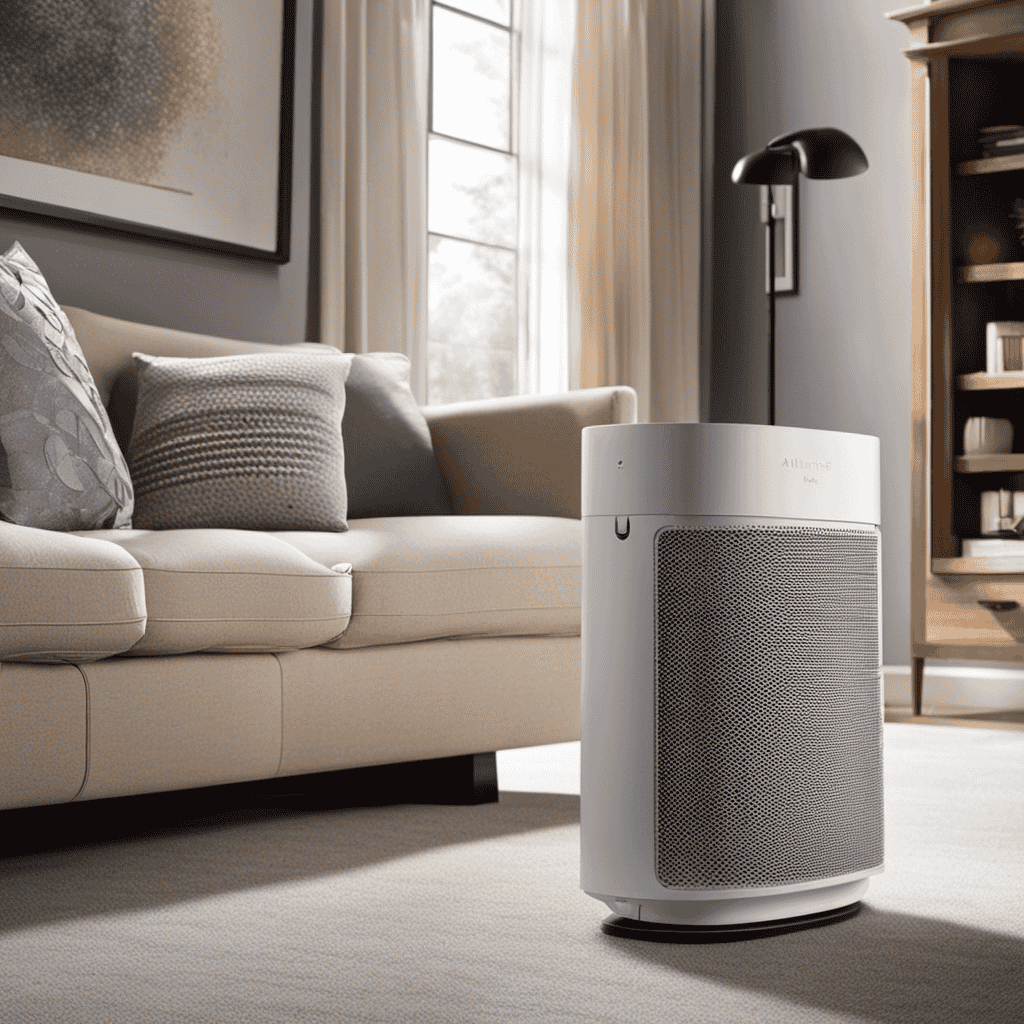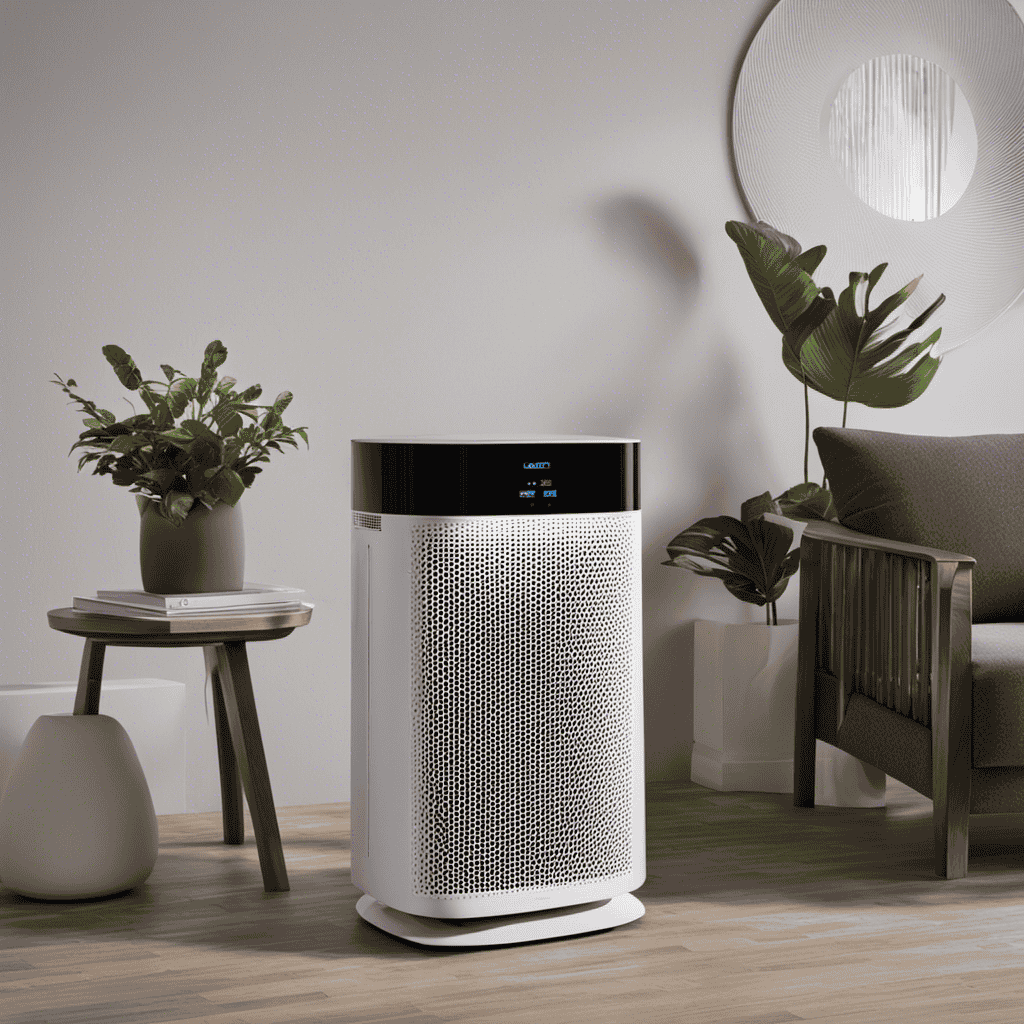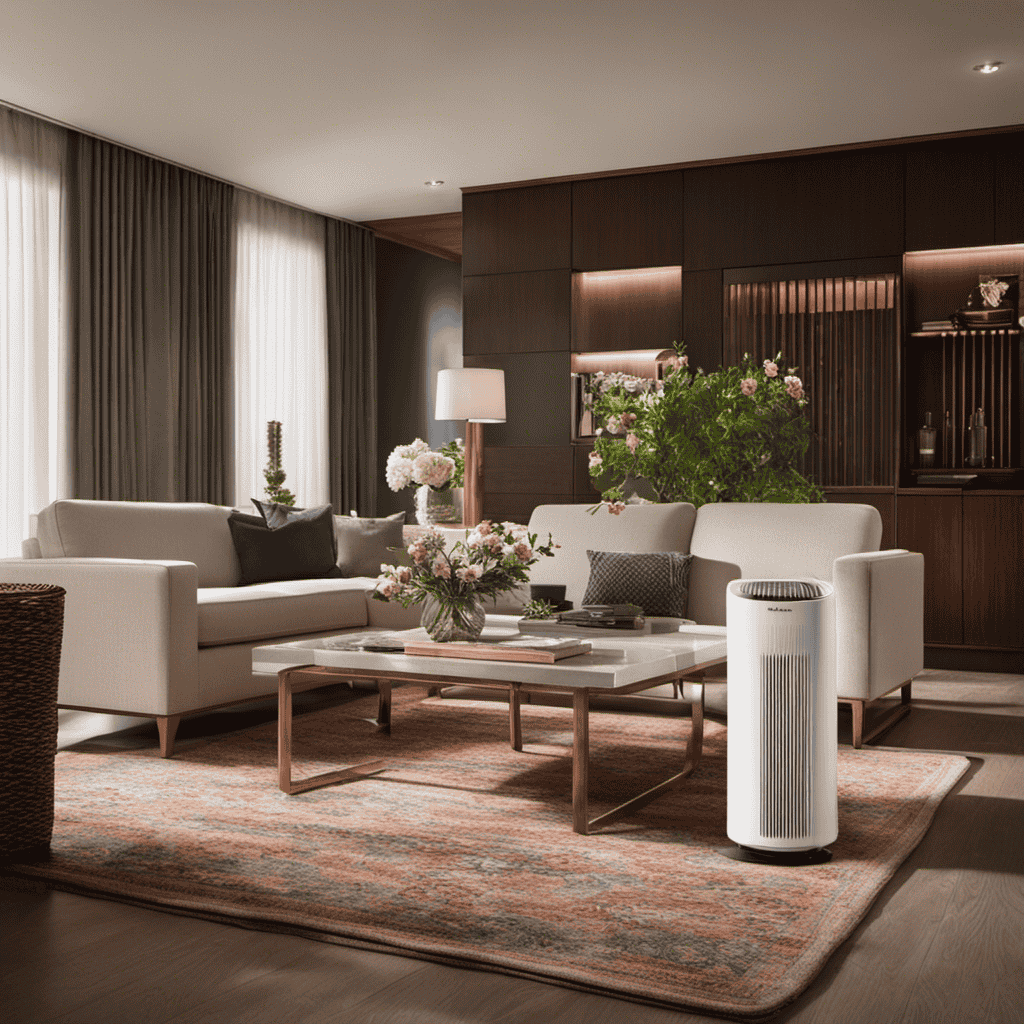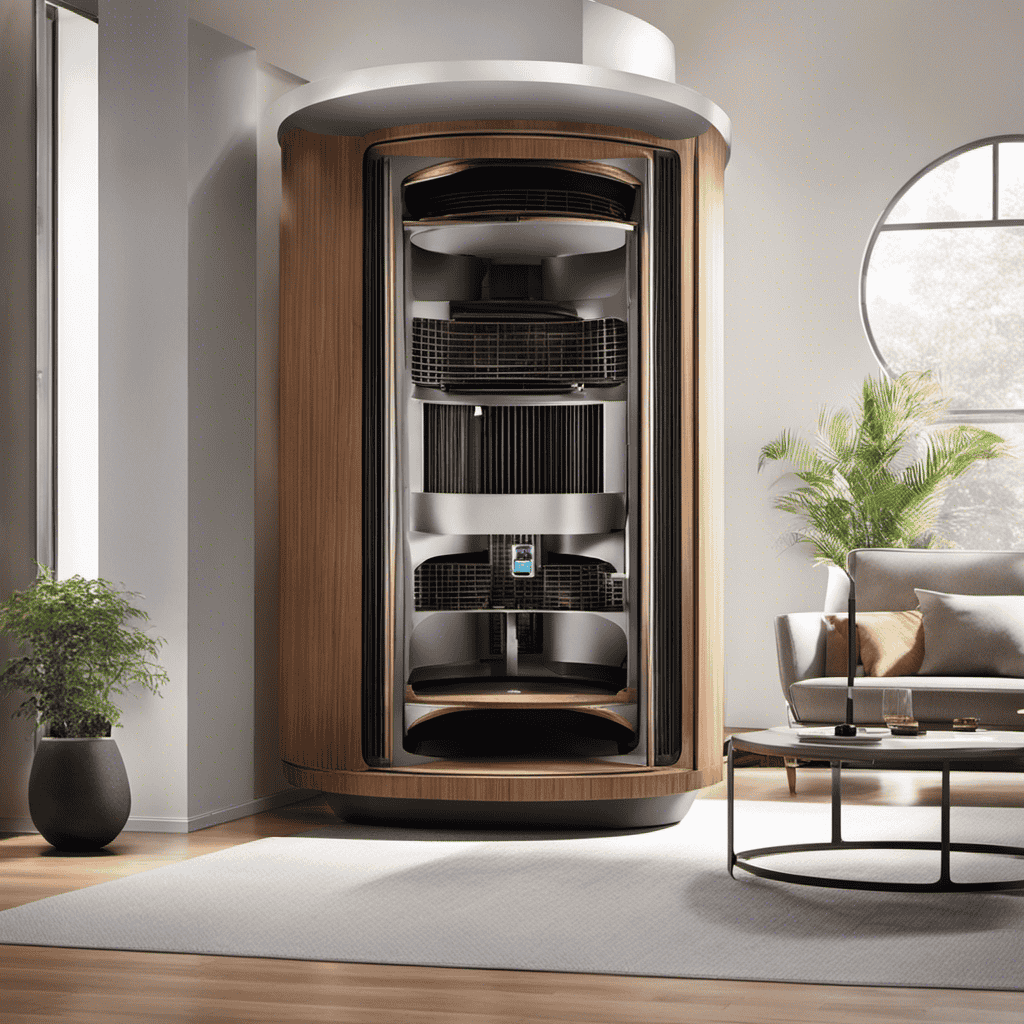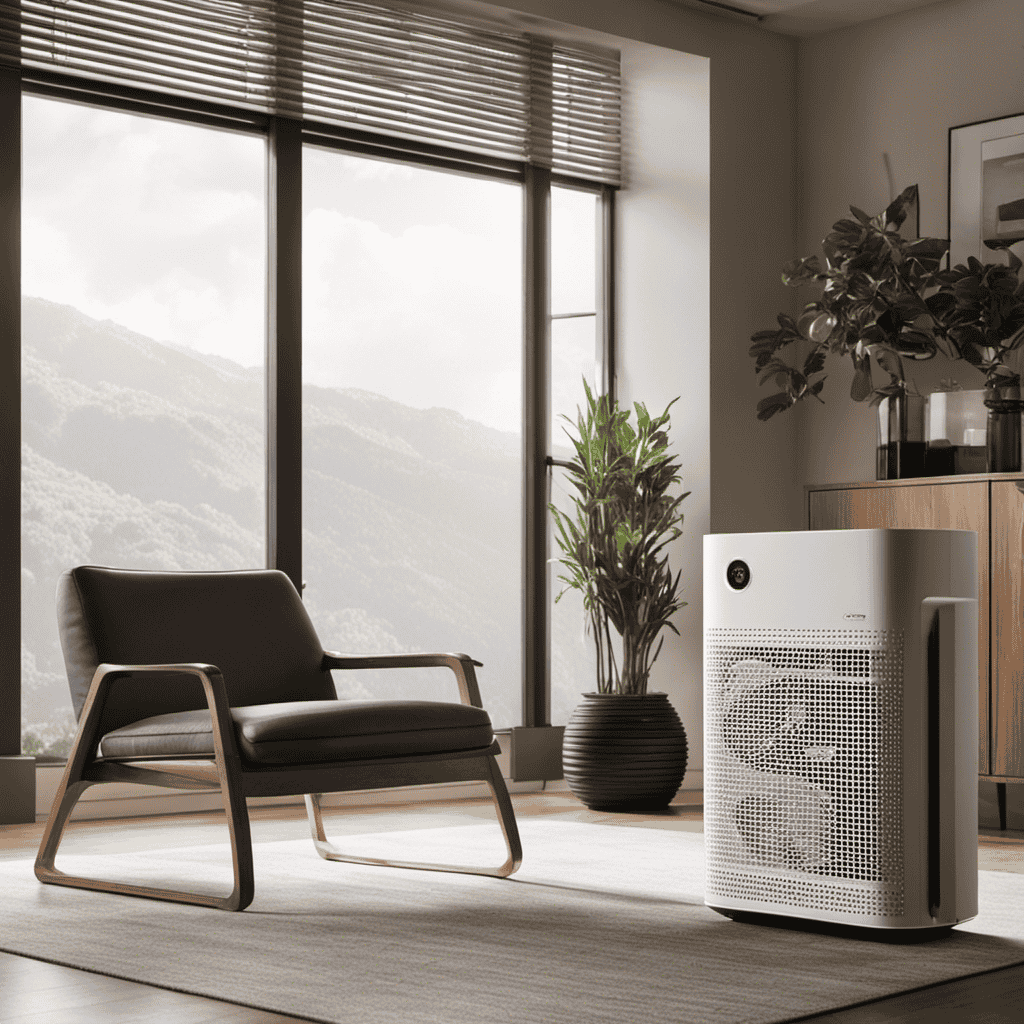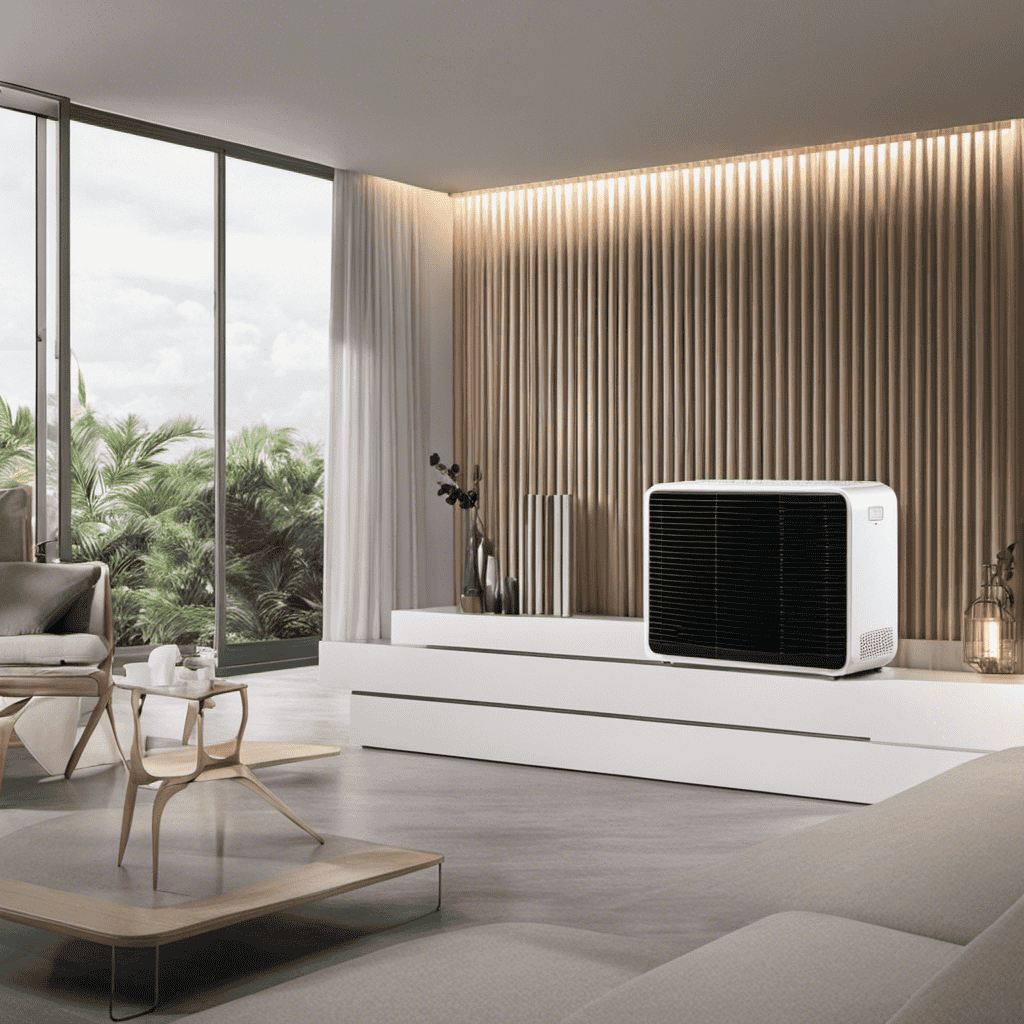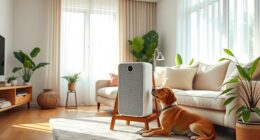As someone who loves clean air, I’ve always found air purifiers intriguing. Discover the secrets behind how **air purifiers** function and improve the quality of the air you breathe.
In this article, I’ll delve into the intricate details of their inner mechanisms, explaining the various filter types and the air purification process.
We’ll explore the effectiveness of HEPA filters, the power of activated carbon filters, and the germ-fighting capabilities of UV-C germicidal light.
I’ll also address important factors like noise levels, energy efficiency, and maintenance requirements.
By the end, you’ll have a comprehensive understanding of how to choose the right air purifier for your needs.
Key Takeaways
- HEPA filters are highly effective in capturing particles as small as 0.3 microns, improving air quality by removing dust, pollen, pet dander, and mold spores.
- Activated carbon filters are useful for eliminating odors, chemicals, and volatile organic compounds (VOCs), making them beneficial for individuals with allergies or sensitivities to odors and chemicals.
- UV-C germicidal light is a technology that kills bacteria, viruses, and other microorganisms in the air, reducing the spread of infectious diseases and improving indoor air quality.
- Pre-filters and electrostatic precipitators play important roles in prolonging the lifespan of the main filter, improving overall efficiency, and removing larger and microscopic particles from the air.
Filter Types
When choosing an air purifier, you’ll want to consider the different filter types available. The effectiveness of an air purifier depends on the type of filter it uses.
There are three main types of filters commonly used in air purifiers: HEPA filters, activated carbon filters, and electrostatic filters.
HEPA filters are highly effective in removing airborne particles and allergens. They can capture particles as small as 0.3 microns, which includes dust, pollen, pet dander, and mold spores. HEPA filters are essential in improving indoor air quality, especially for individuals with allergies or respiratory conditions.
Activated carbon filters are excellent at removing odors, chemicals, and volatile organic compounds (VOCs). They work by adsorbing these pollutants onto the carbon surface. Activated carbon filters are particularly useful in eliminating smoke and cooking odors, making them ideal for kitchens and living rooms.
Electrostatic filters use an electric charge to attract and capture particles. They are effective in removing larger particles like dust and pet hair. However, they may not be as efficient in capturing smaller particles.
Air Purification Process
To understand the air purification process, you should first know that it involves the removal of harmful particles from the air you breathe. Air quality plays a crucial role in our overall health and well-being, and having clean air to breathe is essential.
Air purifiers work by using various methods to eliminate pollutants from the air, such as dust, pollen, pet dander, and smoke. These devices typically contain filters, such as HEPA filters, which capture and trap these particles, preventing them from circulating in the air.
By removing these harmful particles, air purifiers can improve air quality and provide numerous health benefits, including reducing allergy symptoms, decreasing the risk of respiratory infections, and improving sleep quality.
It is important to choose an air purifier that is suitable for your specific needs and consider factors such as room size and filtration efficiency to ensure optimal performance.
HEPA Filters
HEPA filters are essential for capturing and trapping harmful particles in the air. These filters are designed to remove 99.97% of particles as small as 0.3 microns, including dust, pollen, pet dander, and mold spores. Maintaining these filters is crucial to ensure optimal performance and indoor air quality. Regularly cleaning or replacing the filter is necessary to prevent buildup and maintain its effectiveness. Neglecting filter maintenance can result in reduced airflow and compromised air purification. To emphasize the importance of filter maintenance and its impact on indoor air quality, I have created a table below:
| Benefits of Filter Maintenance | Consequences of Neglecting Maintenance |
|---|---|
| Improved air quality | Reduced filtration efficiency |
| Allergen reduction | Increased risk of respiratory issues |
| Cleaner living environment | Decreased lifespan of the filter |
Understanding the importance of filter maintenance sets the stage for discussing the next topic: activated carbon filters, which further enhance air purification by targeting odors and volatile organic compounds.
Activated Carbon Filters
Understanding the benefits of activated carbon filters can help you effectively tackle odors and volatile organic compounds in your home. These filters are designed to remove room odor and chemical pollutants by utilizing the process of adsorption.
Activated carbon is a highly porous material that has the ability to attract and trap a wide range of organic compounds. When air passes through the filter, the activated carbon particles trap the odor molecules and chemical pollutants, preventing them from recirculating in the room.
This adsorption process effectively eliminates unpleasant smells and harmful chemicals, improving the air quality in your home. Activated carbon filters are commonly used in air purifiers and can be particularly useful for individuals who suffer from allergies or sensitivities to certain odors and chemicals.
UV-C Germicidal Light
Using UV-C germicidal light can effectively kill bacteria, viruses, and other microorganisms in your home, helping to create a healthier environment for you and your family. UV-C germicidal light is a type of ultraviolet light that has a wavelength of 254 nanometers. It is commonly used in air purifiers and HVAC systems to eliminate harmful pathogens from the air.
The application of UV-C germicidal light is highly effective in reducing the spread of infectious diseases, such as the flu and common cold. This technology works by damaging the DNA and RNA of microorganisms, preventing their replication and rendering them harmless. The benefits of UV-C germicidal light include improved indoor air quality, reduced respiratory infections, and a decrease in allergens.
Transitioning to the next section, another method for purifying the air is through the use of ionizers and ozone generators.
Ionizers and Ozone Generators
To improve the air quality in your home, consider using ionizers and ozone generators.
Ionizers work by releasing negative ions into the air, which attach to particles like dust, pollen, and pet dander, causing them to become heavy and fall to the ground. This helps to reduce allergens and improve overall air quality.
However, it’s important to note that ionizers can produce ozone as a byproduct, which can be harmful in high concentrations.
Ozone generators, on the other hand, intentionally produce ozone to kill bacteria, viruses, and other microorganisms in the air. While ozone can be effective in disinfecting the air, it can also be harmful to humans and pets if not used properly.
It is crucial to follow safety guidelines and limit exposure to ozone.
Therefore, when considering ionizers and ozone generators, it is important to weigh the benefits of improved air quality against the potential drawbacks and safety concerns associated with ozone production.
Pre-Filters
When it comes to pre-filters, you can easily remove large particles like dust and pet hair from the air before they reach the main filter. Pre-filters are an essential component of air purifiers, ensuring the longevity and effectiveness of the main filter.
These filters are typically made of a coarse material, such as foam or mesh, which traps larger particles and prevents them from clogging the main filter. Pre-filter maintenance is relatively simple and involves regular cleaning or replacement to maintain optimal performance.
By capturing larger particles, pre-filters extend the lifespan of the main filter, reducing the frequency of filter replacements. This not only saves money but also improves the overall efficiency of the air purifier.
Now, let’s delve into the next topic: electrostatic precipitators.
Electrostatic Precipitators
Did you know that electrostatic precipitators can effectively remove microscopic particles from the air?
Electrostatic precipitators are an integral part of the air purification process. They work by charging the particles in the air and then attracting them to collection plates or grids using an electric field. This process is based on the principle of electrostatic attraction, where particles with opposite charges are attracted to each other. The charged particles stick to the collection plates or grids, effectively removing them from the air.
Electrostatic precipitators are particularly effective in removing fine particles, such as smoke, dust, and pollen, which can cause allergies and respiratory issues. By efficiently removing these particles, electrostatic precipitators play a crucial role in improving indoor air quality.
Transitioning into the subsequent section about photoelectrochemical oxidation (peco), it is another technology that can further enhance the air purification process.
Photoelectrochemical Oxidation (PECO
PECO, a technology that uses light and a catalyst to remove pollutants from the air, has gained attention for its potential in improving indoor air quality. Here are some discussion ideas regarding PECO technology:
- PECO technology advantages:
- Highly effective: PECO technology can effectively remove a wide range of pollutants, including volatile organic compounds (VOCs), bacteria, mold, and viruses.
- Continuous operation: Unlike some other air purification technologies, PECO operates continuously, ensuring that the air in the room is constantly being cleaned.
- Low maintenance: PECO devices require minimal maintenance, with no need for frequent filter replacements or cleaning.
- Energy-efficient: PECO technology is designed to be energy-efficient, consuming less power compared to some other air purification technologies.
- Comparison of PECO with other air purification technologies:
- PECO vs. HEPA: PECO technology has shown to be more effective in removing smaller particles compared to High-Efficiency Particulate Air (HEPA) filters.
- PECO vs. Ionizers: PECO technology does not produce harmful ozone gas, unlike some ionizers.
- PECO vs. UV-C: PECO technology can remove a wider range of pollutants, including VOCs, compared to Ultraviolet-C (UV-C) light-based systems.
- PECO vs. Activated Carbon: PECO technology can remove pollutants at a molecular level, while activated carbon filters mainly target odors and gases.
Air Exchange Rates
To improve the air quality in your space, make sure that you are aware of the air exchange rates. Air exchange rates refer to the number of times the air in a space is replaced with fresh air within a given time period. It is an important factor to consider when it comes to maintaining good air quality and ensuring proper ventilation rates. The table below provides an example of the recommended air exchange rates for different types of spaces:
| Space Type | Air Exchange Rate |
|---|---|
| Office | 10-20 ACH |
| Classroom | 6-12 ACH |
| Hospital | 12-15 ACH |
| Restaurant | 8-12 ACH |
| Residential | 4-8 ACH |
CADR and ACH
In my previous subtopic, I discussed air exchange rates and how they impact the efficiency of an air purifier. Now, let’s delve into two important measurements that are used to evaluate the performance of air purifiers: CADR (Clean Air Delivery Rate) and ACH (Air Changes per Hour).
CADR measures the amount of clean air a purifier can deliver in a specific time frame. It is calculated by testing the purifier’s ability to remove various contaminants, such as pollen, dust, and smoke, from the air.
ACH, on the other hand, calculates the number of times the entire volume of air in a room is replaced within an hour. It is determined by dividing the airflow rate of the purifier by the volume of the room.
Understanding these measurements is crucial when selecting an air purifier that can effectively clean the air in your space. So, let’s explore CADR and ACH in more detail.
- CADR measurement evaluates the purifier’s efficiency in removing specific contaminants.
- ACH calculation determines how quickly the purifier can refresh the air in a room.
- Higher CADR values indicate faster and more effective cleaning.
- A higher ACH value means the air is being refreshed more frequently, leading to better air quality.
Noise Levels
Let’s now take a look at the noise levels of air purifiers and how they can impact your overall experience.
When considering noise levels, it’s important to account for factors such as room layout and user preferences.
Room layout plays a crucial role in determining the perceived noise level of an air purifier. For instance, if the purifier is placed near a wall or in a corner, the noise can be amplified and become more noticeable.
On the other hand, user preferences also come into play. Some individuals may be more sensitive to noise and prefer a quieter purifier, while others may not mind a slightly louder machine.
It’s important to consider these factors when choosing an air purifier to ensure optimal comfort and satisfaction.
Energy Efficiency
When it comes to energy efficiency in air purifiers, two important aspects to consider are power consumption and energy-saving features.
In order to compare power consumption, it is crucial to analyze the wattage and energy usage of different models.
Energy-saving features, on the other hand, play a significant role in reducing overall power consumption by intelligently adjusting fan speed, implementing sleep modes, and utilizing sensors to detect air quality levels.
Power Consumption Comparison
The power consumption of air purifiers can vary depending on the model and settings. To help you understand the power consumption analysis of air purifiers and provide you with energy-saving tips, here are some important points:
-
Energy Star Ratings: Look for air purifiers that have earned the Energy Star rating. These models are designed to consume less energy without compromising on performance.
-
Filter Types: Different filter types have different power requirements. HEPA filters, for example, may consume more power due to their dense structure, while activated carbon filters are generally more energy-efficient.
-
Fan Speeds: Higher fan speeds usually result in increased power consumption. Consider using lower fan speeds when the air quality is not severely compromised to save energy.
-
Sleep Mode: Many air purifiers have a sleep mode that reduces power consumption while still maintaining a basic level of filtration. This is a great energy-saving feature to look for.
Energy-Saving Features Explained
Consider using the sleep mode feature on your air purifier to reduce power consumption while still maintaining basic filtration. This energy-saving feature is designed to optimize the performance of your air purifier while minimizing energy usage. By enabling sleep mode, the air purifier will operate at a lower fan speed, resulting in reduced power consumption. This not only helps to lower your energy bills but also contributes to a more sustainable lifestyle by conserving energy resources.
Energy-saving tips like using sleep mode on your air purifier are beneficial not only for the environment but also for your wallet. By reducing power consumption, you can save on electricity costs without compromising the effectiveness of the air purifier in filtering out pollutants and improving indoor air quality.
Transitioning into the subsequent section about maintenance and filter replacement, it is important to note that regular maintenance is crucial to ensure the optimal performance and energy efficiency of your air purifier.
Maintenance and Filter Replacement
Make sure you regularly replace the filters in your air purifier to maintain its effectiveness. Here are some maintenance tips to help you extend the filter lifespan:
-
Follow the manufacturer’s guidelines: Different air purifiers have different filter replacement schedules. It’s important to follow the guidelines provided by the manufacturer to ensure optimal performance.
-
Clean the pre-filter: Many air purifiers have a pre-filter that can be cleaned and reused. Regularly cleaning the pre-filter can help extend the lifespan of the main filter.
-
Vacuum the filter: If your air purifier has a washable filter, vacuuming it regularly can help remove dust and debris, keeping it clean and improving its efficiency.
-
Keep the air purifier in a clean environment: Avoid placing the air purifier in areas with high levels of dust or pollutants. Keeping the surrounding environment clean can help reduce the strain on the filter and prolong its lifespan.
Choosing the Right Air Purifier
When it comes to choosing the right air purifier, there are several key points to consider.
First, you need to evaluate the different types and features available. This includes considering whether you need a HEPA filter, activated carbon filter, or a combination of both.
Secondly, room size is a crucial factor in determining the effectiveness of your air purifier. It’s important to choose a purifier that is suitable for the square footage of your room to ensure optimal performance.
Lastly, filter replacement frequency is another crucial consideration. Different models have varying filter lifespans, so it’s essential to factor in the cost and frequency of replacing filters in your decision-making process.
Purifier Types and Features
There are different types of air purifiers available on the market with various features. When choosing an air purifier, it’s important to consider factors such as room placement and air quality indicators.
Here are four types of air purifiers to consider:
-
High-Efficiency Particulate Air (HEPA) Filters: These purifiers use a dense filter to trap particles as small as 0.3 microns, effectively removing allergens, dust, and pet dander from the air.
-
Activated Carbon Filters: These purifiers are designed to remove odors, chemicals, and VOCs (volatile organic compounds) from the air by absorbing them onto a bed of activated carbon.
-
Ultraviolet Germicidal Irradiation (UVGI) Purifiers: These purifiers use ultraviolet light to destroy airborne bacteria, viruses, and mold spores, helping to reduce the spread of illnesses.
-
Ozone Generators: These purifiers produce ozone, which can help eliminate odors and kill bacteria; however, ozone can be harmful to humans and should be used with caution.
Considering the importance of room size, it’s crucial to choose an air purifier that can effectively clean the air in your specific room.
Room Size Considerations
It’s crucial to choose an air purifier that can effectively clean the air in your specific room, taking into consideration the importance of room size.
The size of the room plays a significant role in determining the efficiency of an air purifier. The layout and dimensions of the room impact the airflow and distribution of pollutants.
To ensure optimal air purification, it is essential to select an air purifier that is suitable for the room’s size. The air quality standards set by regulatory bodies also need to be taken into account. These standards outline the acceptable levels of pollutants in indoor air.
Filter Replacement Frequency
To maintain optimal air quality, it’s important to regularly replace the filters in your air purifier. The lifespan of an air purifier filter can vary depending on factors such as the quality of the filter and the amount of pollutants in the air. However, a general guideline is to replace the filter every 6 to 12 months.
Regular filter replacement offers several benefits:
-
Improved Air Quality: Over time, filters become clogged with dust, allergens, and other particles, reducing their effectiveness. By replacing the filter, you ensure that your air purifier can continue to effectively remove pollutants from the air.
-
Increased Efficiency: A clean filter allows the air purifier to operate efficiently, consuming less energy and saving you money on electricity bills.
-
Prolonged Lifespan: Regularly replacing the filter helps to extend the lifespan of your air purifier, as it reduces strain on the motor and other components.
-
Health Benefits: Clean air is essential for good health. By regularly replacing the filter, you can reduce the presence of allergens and irritants in your home, promoting better respiratory health.
Frequently Asked Questions
Can an Air Purifier Remove All Types of Pollutants, Including Odors and Gases?
Yes, an air purifier can effectively remove various types of pollutants, including odors and gases. Regular maintenance, such as cleaning or replacing filters, is necessary to ensure optimal performance and longevity of the air purifier.
Are Air Purifiers Safe to Use for People With Respiratory Conditions Like Asthma or Allergies?
As someone with asthma, I can attest to the safety and effectiveness of air purifiers for respiratory conditions. Regular maintenance is key to ensure optimal performance and cleaner air.
How Long Do the Filters in an Air Purifier Typically Last Before Needing to Be Replaced?
The filters in an air purifier typically last for different durations depending on factors like usage and filter type. It is recommended to clean or replace filters every 3-6 months for optimal performance and air quality.
Can an Air Purifier Help Reduce the Spread of Airborne Viruses Like Covid-19?
Yes, an air purifier can help reduce the spread of airborne viruses like Covid-19. The benefits of using an air purifier include its effectiveness in trapping and killing viruses, thus reducing the risk of transmission.
Are There Any Potential Health Risks Associated With Using an Air Purifier, Such as Ozone Emissions or Exposure to UV-C Light?
Using an air purifier may carry potential health risks, such as ozone emissions and UV-C light exposure. These risks can have long-term effects on our well-being. It is crucial to consider these factors before using an air purifier.
Conclusion
In conclusion, understanding how an air purifier works is crucial in selecting the right one for your needs. By utilizing different filter types such as HEPA and activated carbon filters, air purification is achieved through the removal of particles and odors.
The addition of UV-C germicidal light ensures the elimination of harmful bacteria and viruses. It is important to consider noise levels, energy efficiency, and regular maintenance for optimal performance.
Remember, choosing the right air purifier is like finding a needle in a haystack – it requires careful consideration and research.
